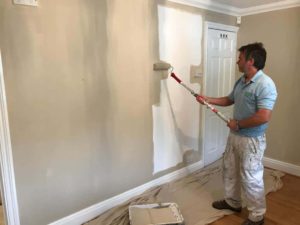
1. The ceiling
The first thing that you need to do is to paint the ceiling. This is important because it enables you to essentially cover the surface with at least two coats without having to worry about any extra bits of paint going onto the walls with the roller. You should use a roller with a double arm frame when you are painting the ceiling. This is important because it offers support at both ends of the roller, which means that even pressure will be distributed across the weight of the roller when you are using it.
2. The walls
The next step is to paint the walls in the room. You should do this once your ceiling has dried. Make sure you apply two coats. It is also a wise idea to prime any areas that are stubborn. It’s advised that you use tape on any skirting board lines or corners but don’t get worried about getting any paint on the skirting boards at this point.
3. The skirting boards
The reason why you did not need to worry about getting any paint on the trim in the former step is that it will now be rectified in this step. Most people will use a high-gloss finish or a semi-gloss finish in order to paint their skirting boards. Use painters tape or masking tape to make sure the cut line is accurate.
4. Door frames and window frames
Next, you are going to tackle the window frames and the door frames. Don’t forget that preparation is imperative when it comes to this task. Make sure that you have caulked the frame’s edges properly against the wall and that you have filled any nail holes. You also need to make sure that you sand down all rough edges before the finish coat is applied. Again, use painters tape and frog tape to make sure the cut line is accurate.
5. The door
The fifth and final thing you are going to paint in the room is the door. The style of the door you are painting will dictate the way in which you paint it. For example, you should always paint the panels first if you are going to be working with panelled doors. A sash brush will help you to get into the profile of the panels, ensuring even coverage. You can then use a mini roller for the flat surfaces and a laying off brush to finish.
So there you have it: the right order of decorating a room. We hope that the information provided in this blog post will help you when it comes to decorating your own home. After all, it is important to make sure that you paint in the right order to make sure that a sleek and stylish job is done in the end. If you’re looking for decorators in Maidstone or the Kent area, get in contact with us today


